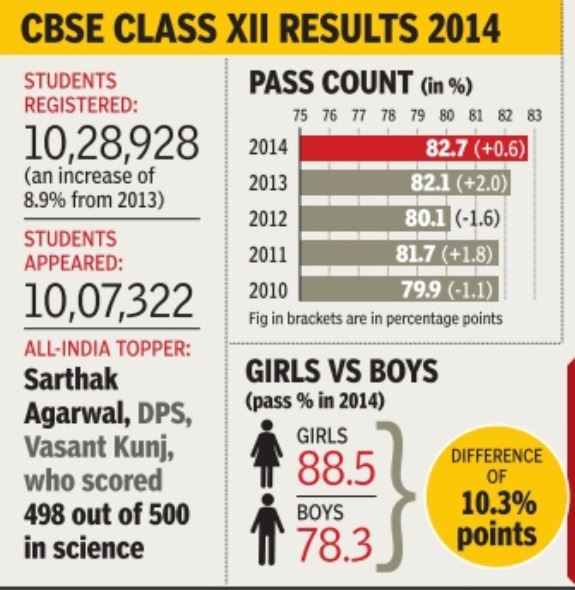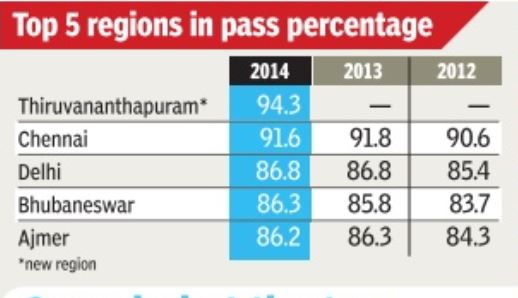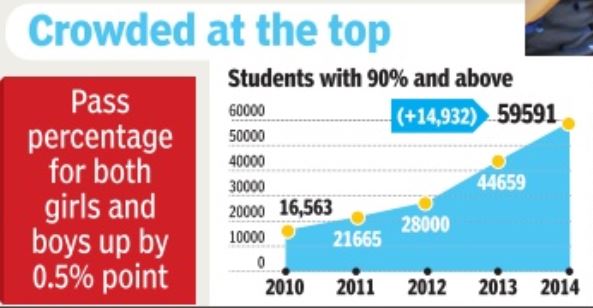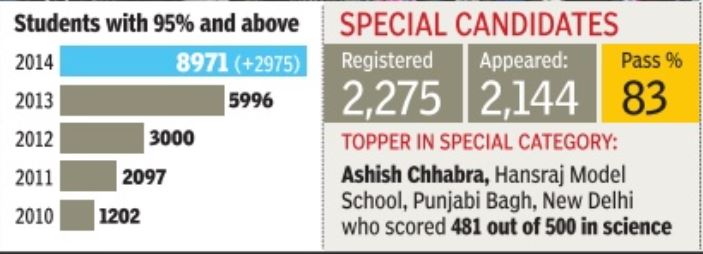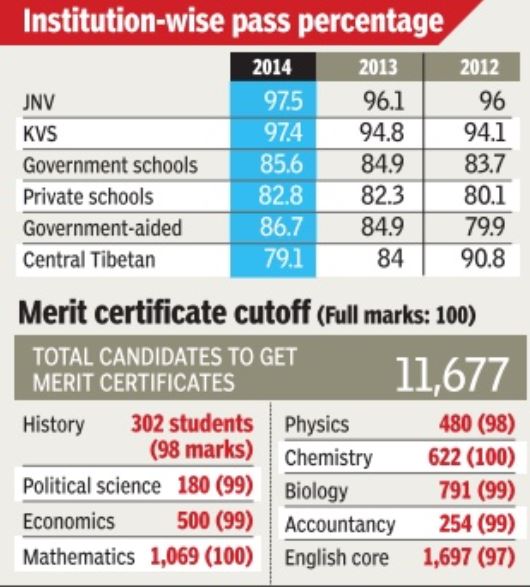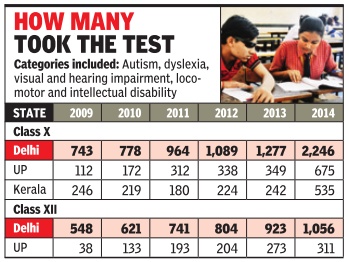Central Board of Secondary Education (CBSE)
(→2015: CBSE exam pattern adopted) |
(→Growth in affiliations: 1996-2013) |
||
| Line 12: | Line 12: | ||
''' No. of CBSE schools triple in 17 yrs ''' | ''' No. of CBSE schools triple in 17 yrs ''' | ||
| + | [[File: CBSE, Grade inflation, 2009-16.jpg| CBSE: Grade inflation, 2009-16; Graphic courtesy: [http://epaperbeta.timesofindia.com/Gallery.aspx?id=24_05_2016_002_032_013&type=P&artUrl=Nervous-90s-Are-high-scores-a-low-point-24052016002032&eid=31808 ''The Times of India''], May 24, 2016|frame|500px]] | ||
Hemali Chhapia Shah & Vinamrata Borwankar | Hemali Chhapia Shah & Vinamrata Borwankar | ||
| Line 35: | Line 36: | ||
Delhi has the largest number of CBSE schools, followed by UP, Haryana and Kerala. | Delhi has the largest number of CBSE schools, followed by UP, Haryana and Kerala. | ||
| − | Maharashtra, which has seen a 67% increase in the number of CBSE schools in the last three years, is home to over 500 institutes. “We have introduced and successfully implemented the continuous comprehensive evaluation system. | + | Maharashtra, which has seen a 67% increase in the number of CBSE schools in the last three years, is home to over 500 institutes. “We have introduced and successfully implemented the continuous comprehensive evaluation system. |
| + | |||
=Class XII results: historical trends= | =Class XII results: historical trends= | ||
CBSE is India's Central Board of Secondary Education | CBSE is India's Central Board of Secondary Education | ||
Revision as of 21:25, 30 October 2016
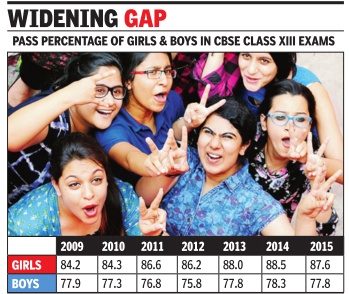
This is a collection of articles archived for the excellence of their
content. You can update or correct this page, and/ or send graphs to the Facebook page, Indpaedia.com. All information used will be duly acknowledged. |
Contents |
Growth in affiliations: 1996-2013
No. of CBSE schools triple in 17 yrs
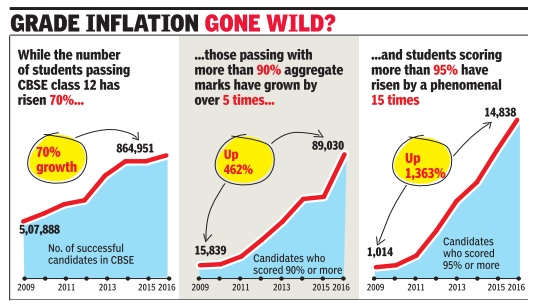
Hemali Chhapia Shah & Vinamrata Borwankar Mumbai:
TNN The Times of India Jun 18 2014
Almost half-a-dozen school boards—local, national and international—offer Indian students a choice of academic algorithms for careers ahead. The landscape of school education has for long promised a variety of options.
But of them all, CBSE (Central Board of Secondary Education), which was largely designed for those who moved home and could not be loyal to a state board, is picking up popularity across the nation.
In 1996-97, there were 4,843 affiliated schools to the CBSE board, which has grown to
15,000 institutes now, with most of the growth attributed to independent private schools, indicating the way the wind is blowing. While every year thousands of Indian parents find it tough to decide which board their child must sign up for, new school managements too face the same quandary when they start operations.
CBSE officials and school principals attribute the board’s popularity to its academic and administrative reforms which are student and school friendly. “Close to 98% of the schools that apply for affiliation are new institutes,” said an officer. Since 2005, the affiliation process is online and information at every stage is sent via electronic mail. “Also, the board is a national board, allowing parents to shift to just about anywhere in the country. The NCERT syllabus is also the most modern and wholesome one which is in tune with the times,” said a
CBSE administrative officer.
Little wonder then that in 2001-02 there were 6,293 affiliated schools, a number which increased to 13,898 in March 2012-13. Most of the growth came from independent institutes, the count of which went up from 3,483 in 2001-02 to 10,290 by the end of 2013.
Delhi has the largest number of CBSE schools, followed by UP, Haryana and Kerala.
Maharashtra, which has seen a 67% increase in the number of CBSE schools in the last three years, is home to over 500 institutes. “We have introduced and successfully implemented the continuous comprehensive evaluation system.
Class XII results: historical trends
CBSE is India's Central Board of Secondary Education
Disabled candidates
Jan 05 2015
Most disabled kids in CBSE exam from city
Shreya Roychowdhury
The largest number of disabled candidates appearing for classes X and XII evaluation under Central Board of Secondary Education (CBSE) is from Delhi.The state-wise count of students with disabilities, released by the Board also showed that the number of differently-abled students appearing for evaluation has been rising steadily . A total of 743 candidates appeared in Class X exam in 2009 in Delhi and more than double the figure appeared in 2014. There were no registrations of autistic students in Class X from 2009 to 2013 from Delhi, but there were five in 2014. Similarly, numbers of students with visual impairment or dyslexia have also increased significantly over the six years -from 214 to 403 in case of blind students and from 93 to 423 in case of those with dyslexia. For the Class XII exam, the biggest jump was in case of orthopedically challenged students. CBSE categorizes them as “handicapped“. In 2009, 272 mobility-impaired candidates from Delhi appeared for Class XII evaluations; the figure rose to 524 in 2014. The number of hearing-impaired students jumped from 25 in 2009 to 130 in 2014.
One of the reasons for the huge difference between Delhi and runners-up Uttar Pradesh, Kerala and Madhya Pradesh is that in Delhi majority of schools are CBSE-affiliated. There is no state board and government schools too come under CBSE.
“Inclusive education is strong in Delhi,“ George Abraham of NGO Score Foundation said adding, “There are more visually challenged students in mainstream schools in Delhi than in any other place in the country. It also depends on the support services, availability of reading material and trained teachers. Delhi is more education-friendly, more aware,“ he said. “Even CBSE is good at handling things here as regional officers are always well-equipped.“ He recalled the case of a student in Surat who was not allowed to use a computer to write his exam.“They were telling him to go to Ajmer. We managed it, but regional offices are not necessarily in sync with the headquarters.“
Madhumita Puri of Society for Child Development, Delhi, said most of the students who have been successfully appearing for these exams are either from private schools or from National Institute of Open Schooling (NIOS). “Sarva Shiksha Ab hiyan has helped and so has stricter implementation of 3% reservation in jobs,” Puri said, “The well-to-do always send their disabled children to school. Now, poor parents too have been making an effort.”
In case of Delhi, the number of students, who appeared for CBSE evaluation in Class X, is close to the num ber appearing in Class XII two years later.
A total of 743 students appeared in Class X evaluation in 2009 and 741 appeared in Class XII exam in 2011. Either the attrition rate is low with those completing Class X choosing to remain in school, or students from other states, where there is a dip in number, are moving in to Delhi.Puri said, “There is a huge migration of visually-impaired students into Delhi, but very little in the other categories.“
2014: Top scoring subjects
The Times of India, Aug 30 2015
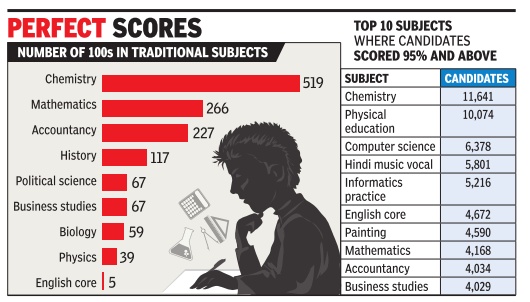
Manash Gohain Chemistry was a cakewalk for students at the Class XII Boards this year. Data on subject-wise scoring pattern from the Central Board of Secondary Education, exclusively accessed by TOI, revealed that not only were a maximum number of 100s scored in chemistry but that over 11,000 candidates also got 95% and more in the subject. The trend of high scores have continued with the number of 100s this year crossing 2,300, up from over 1,900 in 2014. The data also debunked the myth that it's easier to score in vocational electives. Mathematics, English, accountancy and business studies were among the top 10 subjects in which students scored a perfect 100 as well 95% and above. Another highlight: As many as 117 notched up a perfect score in history--a larger figure than physics, biology or business studies this year.
According to CBSE sources, the number of 100s scored among the traditional subjects--chemistry , physics, biology , mathematics, English, accountancy, business studies, history and political science--this year is 1,366. This is despite claims by schools and students that the physics and mathematics papers have been the “toughest“ in a decade. A total of 266 students scored 100 in mathematics and 39 did the same in physics.
The number of candidates scoring 95% and above in individual subjects has also been significant. Candidates have scored 95% and above in 95 subjects out of the total of 193 subjects offered by CBSE at the senior secondary level.
“In all mainstream subjects and well as in popular subjects, students seem to have performed well. Subjects like economics, Hindi core, history, political science, geography are also among the top subjects in which more than a thousand candidates have scored 95% and above. There are 10 subjects in all in which over 4,000 candidates scored 95% and above,“ said a senior official.
One of the reasons for the spike is the grace marks doled out. “Grace marks is nothing new, but this year it has been a bit on the higher side,“ said another CBSE official.
2015: CBSE exam pattern adopted
The Times of India, Nov 21 2015
CISCE rejigs syllabus, follows CBSE exam pattern
The Council for the Indian School Certificate Examination (CISCE) board revamped its syllabus, infrastructure and training methods, with an objective of centralising education. At its 58th annual meeting, the board decided to frame class 12 (ISC) question papers based on the CBSE pattern from 2018. Sample question papers for the ISC exams in 2018 for physics, chemistry , biology and math have been prepared as per the CBSE pattern. For class 10 (ICSE), the syllabus for history , civics, geography , math and physics has been reviewed for 2018. This is to ensure it is relevant, flexible and meaningful in content.
The break-up of marks of the theory and practical components at the ISC level has been revised for the following subjects: Computer science, fashion designing, physical education, Indian music (Hindustani), Carnatic and Western music. The earlier figures of 50% (theory) and 50% (practical) have been changed to 70% and 30%, w.e.f 2016.
The sample papers for these subjects have already been sent to schools and are also available on the council website.
2016
Class X
The Times of India, May 29 2016
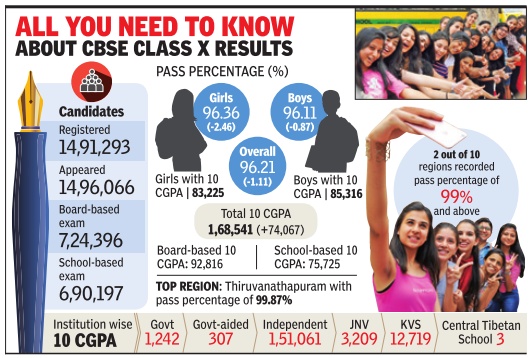
Manash Gohain
The capital had little to cheer about after the CBSE Class X results were declared on Saturday as it recorded the second-lowest pass percentage of 91.76% among all 10 regions. Thiruvananthapuram (99.87%) held on to the top spot. Overall, the pass percentage fell a point from 97.32% last year to 96.21%, though the number of those scoring a cumulative grade point average of 10 crossed the 1 lakh mark for the first time.
Girls outshone boys, albeit by a tiny fraction, after the latter had overtaken them last year. Among the girls, 96.36% cleared the exams compared with 96.11% of the boys. However, the boys held the edge in scoring high grades, with 85,316 of them logging a CGPA of 10 against 83,225 girls scoring the highest grade.
In fact, the number of those obtaining the highest CGPA of 10 rose 40% from that of 2015. A CGPA of 10 represents all those obtaining aggregate marks of 95% or above. For the first time, the number of students crossing the coveted mark went beyond 1lakh, with 1,68,541candidates eventually getting a CGPA of 10. With the introduction of continuous and comprehensive evaluation since 2009, the Class X board exams have become optional. This year, nearly 52% of the candidates opted for the school-based exam. This also means that students wanting their answer scripts to be verified would have to apply separately according to the exam they sat for. According to K K Choudhury , controller of examination, CBSE, students who took the school-based exam would have to apply for verification of grades at their respective schools. For those who took the board-based exam, applications are to be made online within seven days from the declaration of results.
Interestingly, students with a CGPA of 10 outnumbered those getting any other grade. While last year, 7.1% of the candidates had got to a CGPA figure of 10, the number went up to to 11.91% this year. Candidates from private school continued to lead the pack of top scorers with 89.62% of CGPA 10 scorers, a marginal improvement over last year's 89%.
Regionwise, Thiruvanan thapuram again led at the top with a pass percentage of 99.87%. Chennai is the only other region with 99% and above pass percentage among the 10 regions.
The number of attempts permitted for the improvement of grades in Class X has been reduced to one from five since 2013. Candidates can appear for the improvement exam in July .
Of a total of 3,510 diabled candidates, 3,335 qualified with a pass percentage of 95.18%. The server was down for nearly 40 minutes as soon as the results were released.
